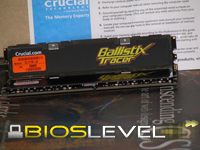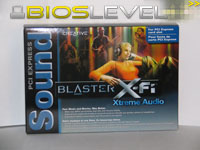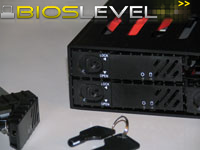Crucial was created by Micron in 1996 as a response to consumers wanting memory upgrades to get the best possible performance from their systems. Currently, they offer over 217,000 upgrades for more than 27,000 desktops, notebooks, servers, printers, routers, and other electronic devices on their website.
Crucial’s Website & Tools
Crucial has one of the most useful manufacturer websites we’ve ever come across. As soon as the page has loaded, you’re greeted with two options to find the best possible memory upgrades for your system: Selection by Motherboard, or a System Scanner.






The Product
Product Number: BL2KIT12864AL804Timings: 4-4-4-12Extra Features: SLI-ReadyMy 2GB of Ballistix came in Crucial’s standard packagine: a small box inside a bigger box for protection. Slice the seal on the smaller box and you’re in for a treat when you spot your new RAM.
Installation
Installation was simple, as is any RAM installation. I opened up the clips and removed the old ram, and then replaced it with the two sticks of Ballistix Tracer. Make sure you’ve got an anti-static wristband on so you’re grounded, and that the powersupply is off. It’s always to good idea to take both of these precautions when installing anything in your PC to avoid breaking or damaging components before you’re able to use them. Make sure they’re firmly in place, then boot your PC back up! It’s interesting to watch the RAM while your PC boots, as you can see when the RAM actually comes online via the LEDs on top.
Watch the lights!
The fun part of the RAM is watching the LEDs! There are 2 rows of 8 LEDs on the top of the RAM. These LEDs circulate in random patterns based on RAM usage. The colors vary from green to red depending on usage. Additionally, there are there are 8 more blue LEDs at the base of the RAM that are constantly lit, giving off a nice illuminating effect against your motherboard.
| System 1 | System 2 | |
| Case | Thermaltake Soprano DX (Provided by Thermaltake) | |
| Processor | AMD Athlon X2 3600+ | |
| Motherboard | ECS GeForce6100SM-M | |
| RAM | 1GB Super Talent CL5 DDR2-800 | 2GB Crucial Ballistix Tracer DDR2-800 |
| Graphics | ATi Radeon X600 SE | |
| Hard Drive | Maxtor 100GB SATA | |
The only bottleneck I can see in this configuration is the Radeon X600. It’s unfortunately an SE edition of the graphics card, and only provides us with an PCI-Express x8 link, using on half the bandwidth the x16 port it’s plugged in to. Hopefully the RAM is able to give us noticable performance boosts to forgive the video card’s shortcomings.
Benchmarking
We’ve chosen not to attempt overclocking the Crucial Ballistix. While we are an enthusiast website, we’re looking to see the stock value of the hardware (that, and our motherboard isn’t the most overclockable motherboard). First, we’ll be looking at Sandra’s memory bechmarks. You can find out more about Sandra here. Note that these are theoretical benchmarks and don’t say as much for real-word performance. That’s what gaming is for.
| Sandra | System 1 | System 2 (Ballistix) |
| RAM Bandwith Integer Performance (higher is better) | 4746MB/s | 5387MB/s |
| RAM Bandwidth Float Performance (higher is better) | 4753MB/s | 5349MB/s |
| Random Memory Access (lower is better) | 91 ns | 96 ns |
| Memory Access Speed Factor (lower is better) | 58 | 58.6 |
| Cache and Memory Speed Factor (lower is better) | 11.9 | 9.5 |
| Cache and Memory Combined Index (higher is better) | 8128MB/s | 9014MB/s |
I found it odd that the CL5 outperformed the Ballistix in a few areas. I have a feeling something may be hampering the RAM’s performance, and most likely it is the motherboard. The Random Memory Access should probably be much lower than it is. This is most definitely caused by the motherboard. Again, these are only theoretical benchmarks and you can’t base real word performance from them.For a more real-world look at how the RAM is going to perform, we’ve selected a few choice games. Using the same systems as above, let’s see if the RAM improves gameplay for our favorite games, as well as 3dMark05. For Counter-Strike: Source, we used the Video Stree test from the main menu. For UT2004, we chose to use the default settings and created a benchmarked-mode botmatch with the following command-line options: dm-rankin?spectatoronly=1?numbots=12?quickstart=1?attractcam=1 -benchmark -seconds=77 -ini=default.ini
| Gaming Performance | System 1 | System 2 (Ballistix) |
| Counter-Strike Average FPS (higher is better) | 32.04 Avg FPS | 38.05 Avg FPS |
| UT2004 Botmatch Lowest FPS(Default Settings, higher is better) | 26.7 | 26.7 |
| UT2004 Botmatch Average FPS(Default Settings, higher is better) | 86.00 | 89.1 |
| UT2004 Botmatch Highest FPS(Default Settings, higher is better) | 262.6 | 281.8 |
| 3dMark05 | 1244 | 1280 |
I was much more delighted to see the gaming scores over Sandra’s. The Crucial Ballistix Tracer improved performance across the board, although not by much. We gained a few frames per second in both UT2004 and CS:S, and only a meager 36 points in 3dMark05. As we guessed earlier, the graphics card seems to be a major bottleneck in our system. With a better card, we imagine we’d see drastic improvements and bigger differences between the two brands of RAM.Regardless of the videocard, the RAM performed very well in the benchmarks we’ve selected. More than that, the colorful LEDs keep us distracted while we let the benchmarks run. Let’s move along and look at the big picture of the RAM with our conclusion.Regardless of the videocard, the RAM performed very well in the benchmarks we’ve selected. More than that, the colorful LEDs keep us distracted while we let the benchmarks run. Let’s move along and look at the big picture of the RAM with our conclusion.Crucial’s got a great product with it’s Ballistix Tracer line of RAM. Not only does it perform incredibly well, but it’s got LEDs than change with RAM activity. Regardless of whether your an enthusiast, case modder, or general PC user, you’re going to be happy with this RAM!Not only have we seen a great product from Crucial, but we’ve also explored the tools they offer to help consumers find the right RAM upgrades for their machines. It doesn’t take a genius to figure out how to find an upgrade with their website. Between their system scanner and manual selection, Crucial offers a service well above any other memory manufacturer out there!From the light-up, activity-monitoring LEDs, blue LEDs along the bottom, and great speed, we loved everything about this RAM. Plan to see it in future reviews.Pros:
- – LEDs that monitor activity
- – LEDs that are constantly lit and illuminate the motherboard
- Great timings and latency at 4-4-4-12
- Heatspreaders to reduce head
- Superior Gaming Performance
Cons:
- None!







